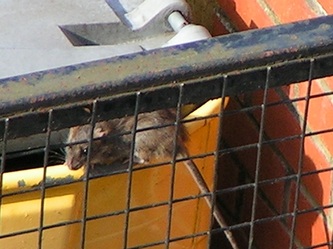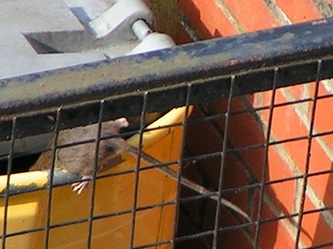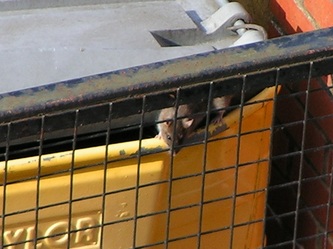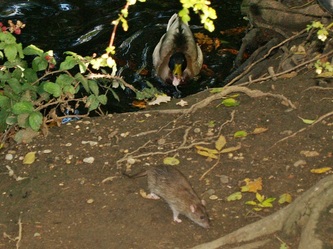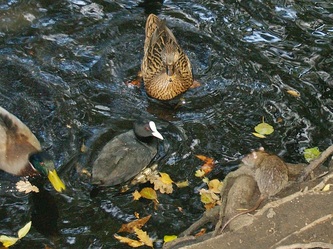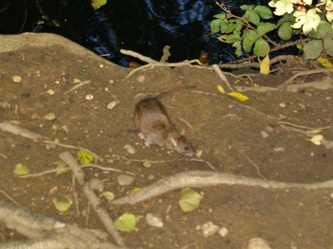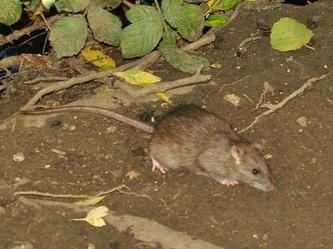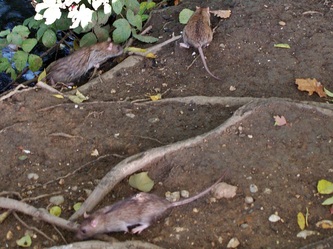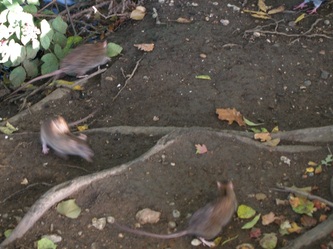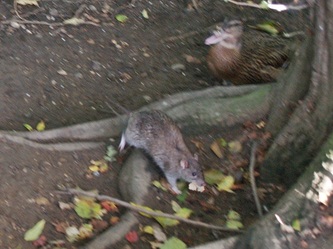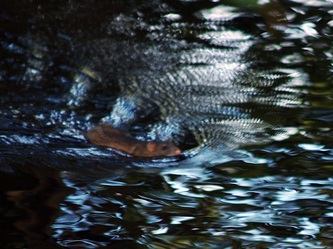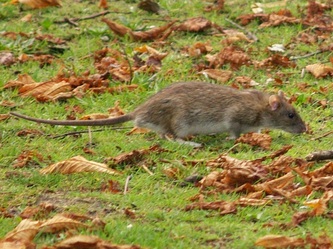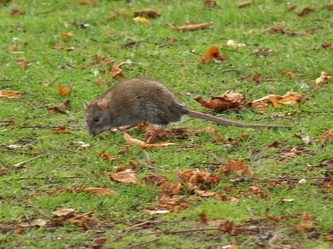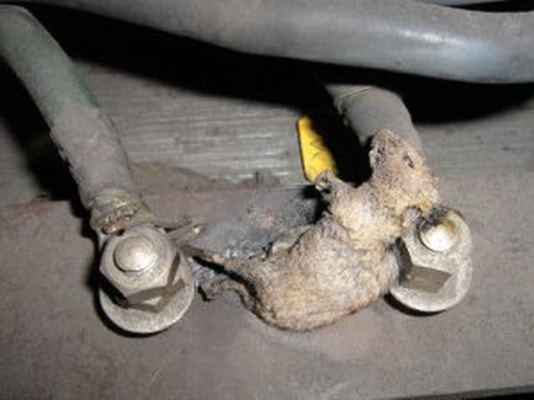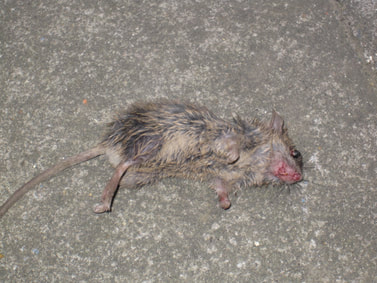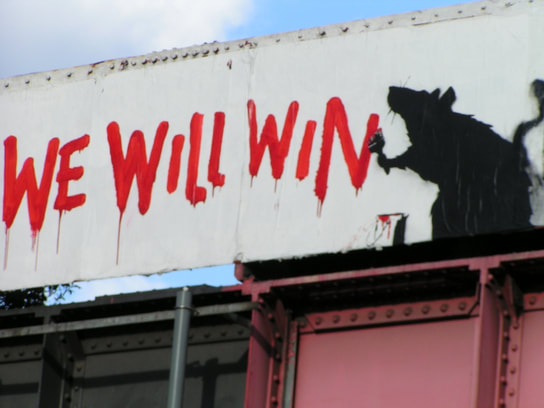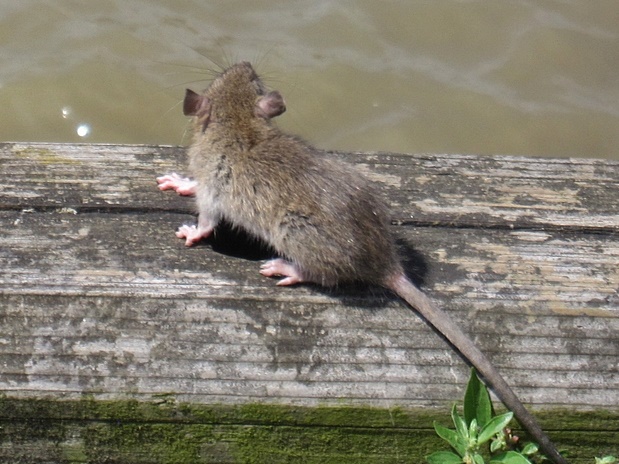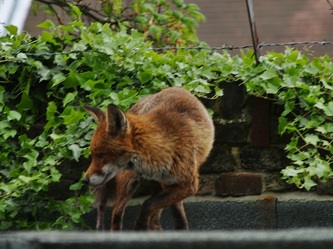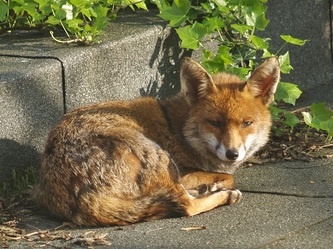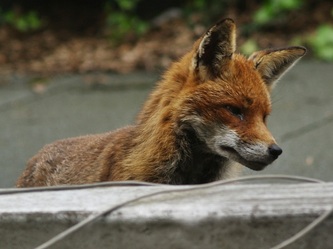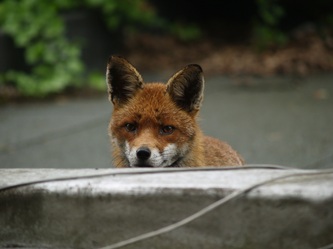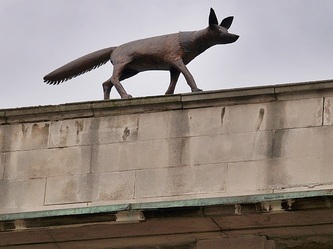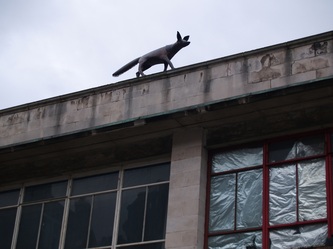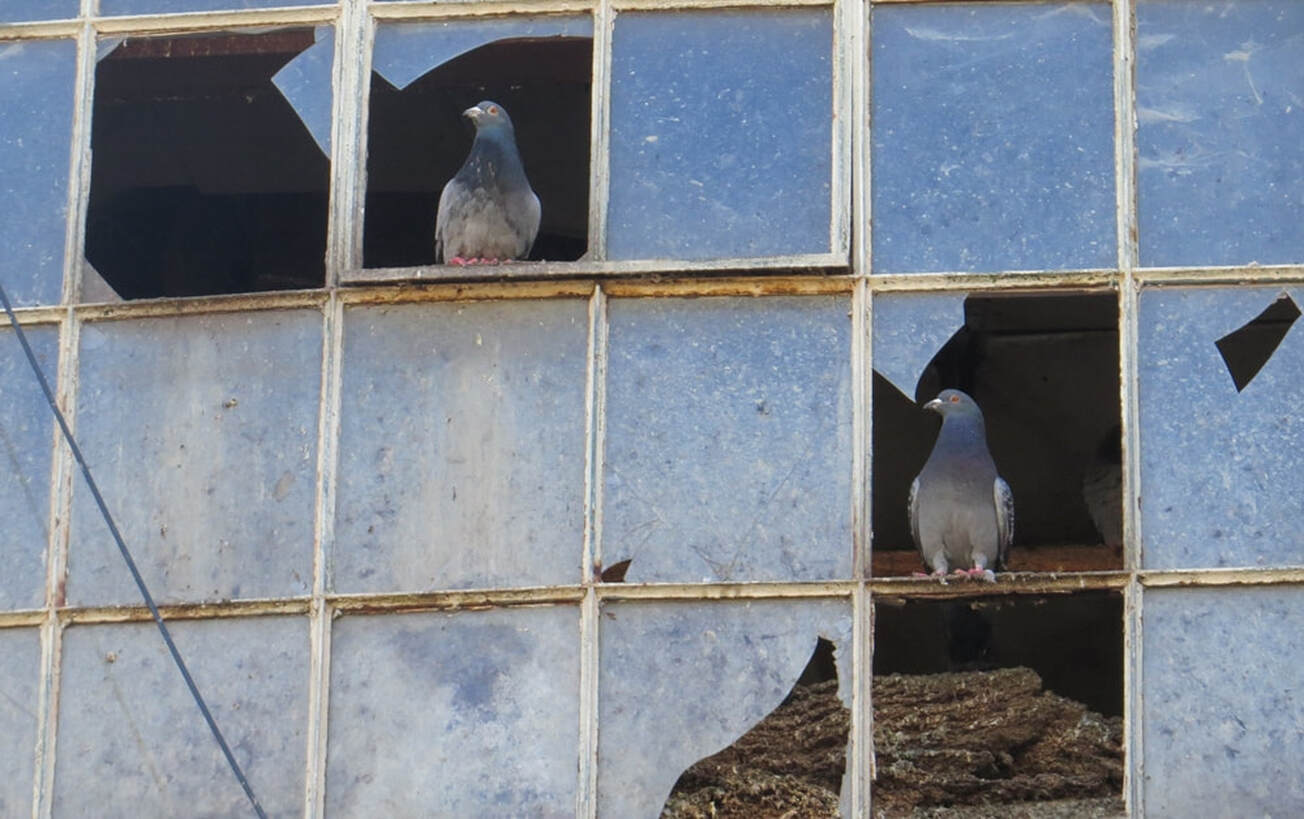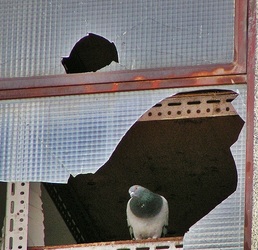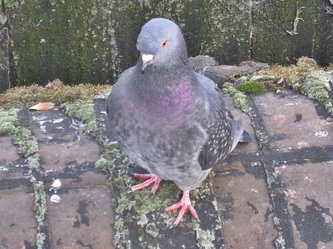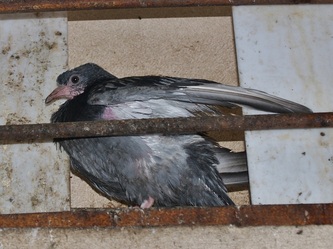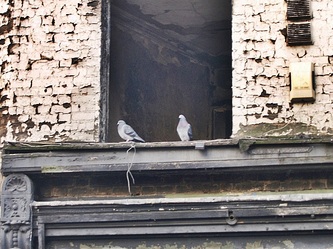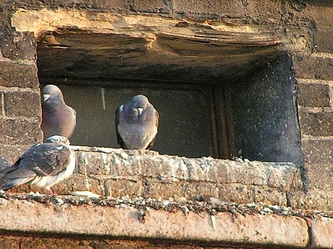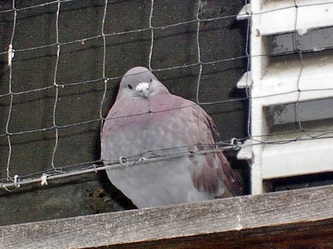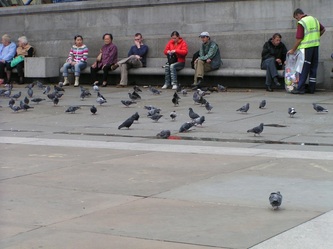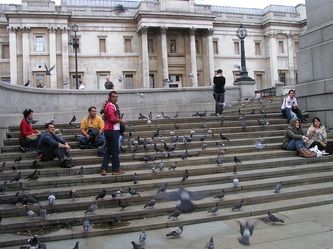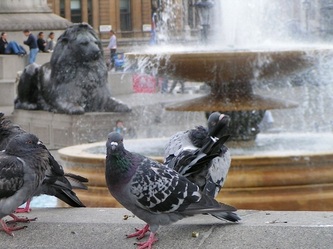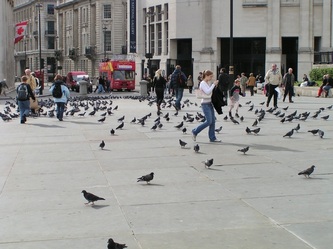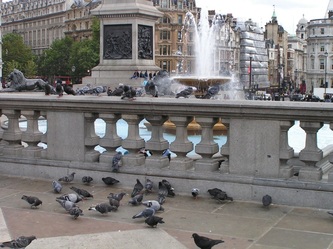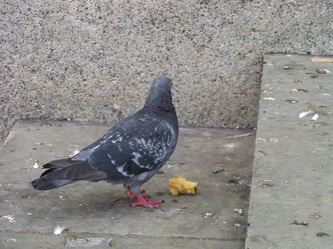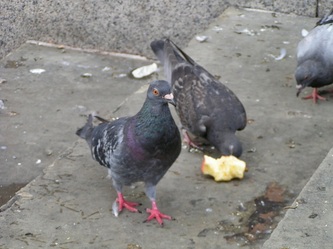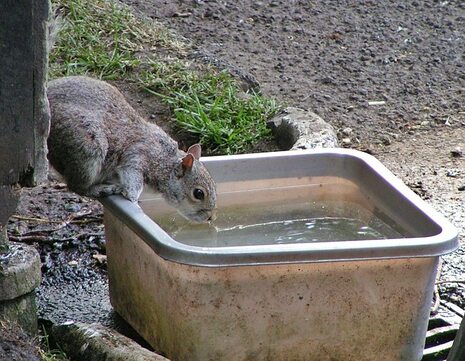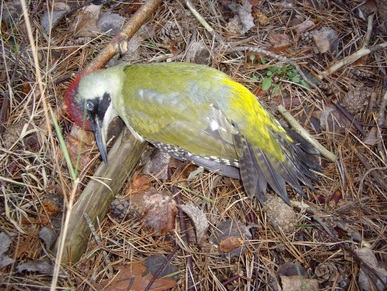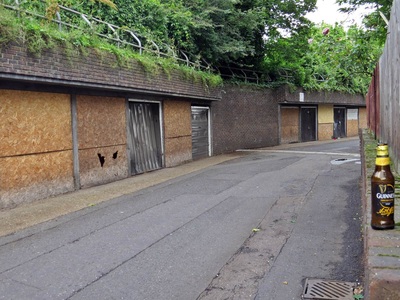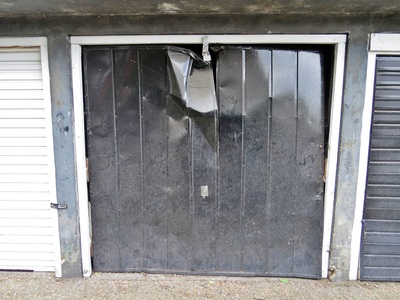Derelict London - Wildlife
RATS
Despite stories of "never being further than a few feet from a rat in London" its rare to see one (especially in daylight with a camera in your hand). Here, I managed to picture a rat in Bayswater searching for food in a wheelie bin behind a restaurant. I watched it climb up the wire gate and squeeze its body into the bin.
The rats in present-day London are brown rats [rattus norvegicus), which didn't arrive here until the late 1720s. the London plague of 1665, and the earlier black death pandemics were caused by plague carried by fleas on the coats of black rats [rattus rattus]. black rats are now one of the rarest mammals in Britain, and although there were small colonies in London [around Oxford Street,and Canning Town] in the 1980s, the assumption is that they are probably extinct in the capital. Brown rats are far more 'adaptable' to change, burrow rather than climb, and with the replacement of timber-framed buildings [which black rats used to climb and nest in] by bricks and mortar, the habitat for black rats was reduced. since the 1730s we have seen a gradual but effective replacement of black rats by brown across the uk.
The rats in present-day London are brown rats [rattus norvegicus), which didn't arrive here until the late 1720s. the London plague of 1665, and the earlier black death pandemics were caused by plague carried by fleas on the coats of black rats [rattus rattus]. black rats are now one of the rarest mammals in Britain, and although there were small colonies in London [around Oxford Street,and Canning Town] in the 1980s, the assumption is that they are probably extinct in the capital. Brown rats are far more 'adaptable' to change, burrow rather than climb, and with the replacement of timber-framed buildings [which black rats used to climb and nest in] by bricks and mortar, the habitat for black rats was reduced. since the 1730s we have seen a gradual but effective replacement of black rats by brown across the uk.
(Above) DULWICH - BELAIR PARK RATS
Despite the numerous poison traps, rats freely roam around the area near the ornamental lake which is said to be a tributary of the buried River Effra. People are being discouraged to feed the wildlife as its been encouraging the rats who feed alongside the ducks. There are reports on a local forum of a council official using a baseball bat to kill rats which has caused some distress amongst onlookers and their children.
Despite the numerous poison traps, rats freely roam around the area near the ornamental lake which is said to be a tributary of the buried River Effra. People are being discouraged to feed the wildlife as its been encouraging the rats who feed alongside the ducks. There are reports on a local forum of a council official using a baseball bat to kill rats which has caused some distress amongst onlookers and their children.
(Above) SOUTH KENSINGTON TUBE
Jon who worked on the tube took the above pic - this rat caused a shut down of the District Line on London's Underground on the 5th October 2006. As you can see the rat shorted out across the 630vDC connectors. The result was that the traction current switched off via the fail safe devices and a line walk had to instigated to find the cause of the dead short. They do not simply switch back on the current until they can be sure that it won't suddenly short out again.
Jon who worked on the tube took the above pic - this rat caused a shut down of the District Line on London's Underground on the 5th October 2006. As you can see the rat shorted out across the 630vDC connectors. The result was that the traction current switched off via the fail safe devices and a line walk had to instigated to find the cause of the dead short. They do not simply switch back on the current until they can be sure that it won't suddenly short out again.
HANDY GUIDE TO RATS
According to the 1995 National Rodent Census, one in 20 UK properties is infested with rats.
Rats are beneath your feet in the old London sewer tunnels. If you walked down a sewer and trod on a dead rat it would be likely to explode like a chicken kiev!
Every hour in London 4000 rats are born!
THAMES Water has agreed to discuss the rat problem in the sewer system. At an environment committee, chairman Cllr Eric Williams said "One rat can produce 2,000 rats in one year. It can be a major problem."
It is said that you are never more than twenty feet away from a rat in London
In the summer of 1665 London suffered an outbreak of the bubonic plague. It was brought to London by rats on board the ships that brought goods from overseas. The plague spread rapidly and once infected, the chances of survival were very slim. During the yearlong outbreak 100,000 people died.
"Far from there being any romance in the tales told of the rats, these vermin are really numerous and
formidable in the sewers, and have been known, I am assured, to attack men when alone, and even
sometimes when accompanied by others, with such fury that the people have escaped from them
with difficulty. They are particularly ferocious and dangerous, if they be driven into some corner whence
they cannot escape, when they will immediately fly at any one that opposes their progress."
Victorian Sewer flusherman
The British rat population is estimated at somewhere around 60 million, which is pretty much the same as its human population. The main differences are the rats' superior repro capabilities. Rats can kill us: their urine can carry a water-borne bacteria causing liver or kidney failure.
CLAPHAM - URBAN FOX
The red fox is a native relative of the dog common throughout Britain. Extremely adaptable, it is an established resident of our urban environment. It is estimated that there are 10,000 foxes now roaming London. These urban foxes are noticeably bolder than their country counterparts and are often seen boldly walking around backyards. In urban areas, scavenged food can constitute up to 50% of their diet as foxes eat what we discard.
Some people regard foxes as a nusiance though in my experience the biggest nusiance around London is usually caused by people........
Some people regard foxes as a nusiance though in my experience the biggest nusiance around London is usually caused by people........
Artist Lucy Casson who created these foxes and cherries on a rooftop in Brixton says "Electric Avenue is the perfect place for these foxes to scavenge cherries from the market. I like the way foxes live among us; they are part of the layers of London."
PIGEONS
Officials say millions of pigeons in London are disease-ridden and have no respect for statues and historic buildings. They say it costs thousands of pounds every year to clean up after them. The previous Mayor of London Ken Livingstone said pigeon droppings have caused up to £140,000 damage to Nelson's Column and the square.
Volunteers turn up at Trafalgar Square every day to scatter seeds often clashing with people employed to scare off the flocks using megaphones, a vacuum device to suck up the seeds and three Harris hawks. All wild birds have the potential to pass on diseases to other birds and to human beings but the chances of this happening are a million to one, certainly in the case of human beings. Pigeons are no more likely to transmit diseases to human beings than any other species of wild bird. Despite the efforts of "Heritage Wardens" to chase off the pigeons quite a few can be seen again around Trafalgar Square!
SAVE THE PIGEONS WEBSITE: www.savethepigeons.org
Volunteers turn up at Trafalgar Square every day to scatter seeds often clashing with people employed to scare off the flocks using megaphones, a vacuum device to suck up the seeds and three Harris hawks. All wild birds have the potential to pass on diseases to other birds and to human beings but the chances of this happening are a million to one, certainly in the case of human beings. Pigeons are no more likely to transmit diseases to human beings than any other species of wild bird. Despite the efforts of "Heritage Wardens" to chase off the pigeons quite a few can be seen again around Trafalgar Square!
SAVE THE PIGEONS WEBSITE: www.savethepigeons.org
GREY SQUIRRELS
Grey squirrels are an alien species and were introduced to the UK from the USA in the late nineteenth/early twentieth century. Their success has been to the detriment of our native red squirrels. Grey squirrels – along with pigeons & foxes - split public opinion and while many people enjoy watching them, others view them as nothing more than tree rats. They can find their way into roof spaces of buildings – either by climbing the walls or leaping across from a nearby tree – where they can be very destructive, tearing up insulation to use as nest material and chewing the timbers. They have also been known to strip the insulation off electric cables – a major potential fire risk.
RICHMOND - DEAD GREEN WOODPECKER
South Bromley - Stray Cat in Derelict GarageIn a row of abandoned garages just off the Blackwall Tunnel approach in Tower Hamlets I spotted this shy cat who has made one of the garages it's home. Someone had kindly left a bowl of water near the entrance hole. The Celia Hammond Animal Trust (CHAT) report that there are estimated to be 2 million stray cats on U.K streets and the true figure may be much higher. Increasing numbers of pet owners are being forced to abandon their animals because they can no longer afford to keep them in the economic crisis.People often cant afford neutering or even accomodate their pet when downsizing properties. Meanwhile, many owners have become amateur breeders to supplement their income which has caused an explosion in the cat population.One unneutered female cat can produce 18 kittens in a year and can end up with 20,000 descendants in just five years. The Cat Protection League claims the stray cat population has now hit an all-time high as shelters struggle to keep up with the huge numbers of cats being brought in. |
When an unneutered female pet cat gets lost or is abandoned, unneutered male cats will mate her. She will give birth to the kittens wherever she can. This is often in derelcit sites or anywhere she feels she may be safe. Unless the kittens are discovered when they are very young, generally the first anyone will be aware of them will be when they are brought out by their mother to look for solid food at around six weeks old. At this age the kittens will already be nervous of human contact because they have not been handled and socialized. This nervousness is sometimes termed 'wild' this is the result of lack of handling. If the cat and her kittens are rescued, the kittens can be tamed.
Animal welfare charities in London have said they are being overwhelmed by a huge increase in the number of feral cats, and many have had to be put to sleep. A project run by The Snip Feral and Timid Cat charity is relocating the cats to the Midlands, where the strays are given new homes.Because the cats are feral they are being put to use on farms, where they are "very good mousers", according to the charity.
Animal welfare charities in London have said they are being overwhelmed by a huge increase in the number of feral cats, and many have had to be put to sleep. A project run by The Snip Feral and Timid Cat charity is relocating the cats to the Midlands, where the strays are given new homes.Because the cats are feral they are being put to use on farms, where they are "very good mousers", according to the charity.
Paul Talling's Derelict London - all photographs are copyright © 2003-2024
Click the envelope icon to join the mailing list for occasional news on website updates, new book releases and Paul's guided walking tours. Follow Derelict London on Facebook and Twitter
Please do not contact me with property/ filming/photo shoot location queries
Click the envelope icon to join the mailing list for occasional news on website updates, new book releases and Paul's guided walking tours. Follow Derelict London on Facebook and Twitter
Please do not contact me with property/ filming/photo shoot location queries




